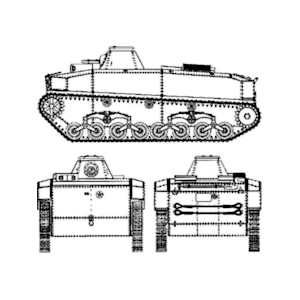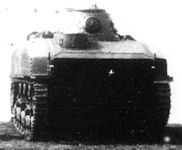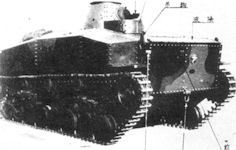SR-I "I-Go" (Suiriku-Ryoyo I)
Japan, like most states after the Great War, wanted to have a light reconnaissance tank armed with weapons that could overcome water obstacles. In 1928, two prototypes of floating armored vehicles were built following the example of the Vickers Volsley, but Japan needed an amphibious (Suiriku-Ryoyo = amphibious) tank of tis owm. From here originates the deplorable history of the SR series tanks.
As part of the observation of various tanks with more or less good swimming properties in Europe in the late twenties, the army's desire for a light tank with buoyancy. After some partly successful experiences that had been made in 1930/31 with an amphibious half-armored car, the army approached Mitsubishi in 1933 with the order to develop an amphibious tank with full-track drive.
In fact, a series of SR (Suiriku-Ryoyo = amphibious) tanks, designed by Mitsubishi engineers, was created to work out all sorts of innovations that were not previously used in Japanese tank design. They began to build under the model name SR such a vehicle with 3.7 t weight for testing purposes. In 1934, the first prototype was built, called SR-I "And-Go" (Suiriku-Ryoyo I). In fact, it was an SS-Ki engineering vehicle modified under a amphibious tank.
As a drive, a modified version of the drive type 89 tanks was used. The foremost impeller was dropped. The other eight wheels were combined in pairs and in turn cushioned in pairs on leaf spring packages. The drive was via the drive wheel at the rear. Three support rollers and the stator completed the drive. The structure was riveted almost box-shaped and thus offered a poor sea condition. Above the tracks floating elements with several chambers were mounted on both sides. The small track track was made of steel single-flange tracks.
The tank was equipped with a 4-cylinder petrol engine producing 70 hp. and manual transmission. Movement in the water was to be ensured by the work of the tracks and the keel, which was mounted on the aft of the hull. The tank was quite high and was divided into several compartments, like a ship. A mechanic-driver was located in the front part, above which there was a cylindrical cabin with a viewing slot. The middle part was occupied by the fighting compartment with a single conical turret, which was equipped with a 6.5-mm machine gun. Peculiar floats were mounted on the sides of the hull, and the flaps in the forward part should be protected from the incident wave.
In order to prevent a flushing over of the bow and thus a submergence, a baffle plate at the bow could be folded up by the driver by a simple mechanism. This sat in front right and had a small cylindrical dome with view flaps available. Behind the driver was positioned in the middle of the vehicle a strongly conical turret with a 6.5 mm type 91 MG in standard MG cover. In the rear, a 70 hp engine was installed, which moved the vehicle forward both on land and in the water on the chains.
However, tests showed that if on land the maximum speed of the SR-I was 24 km / h, then in the water, even with additional modifications, it barely reached 9 km / h. The vehicle proved to be poorly manoeuvrable in the water - the afloat car was completely unmanageable, and poor sea conditions only increased the resulting problems. The army rejected the project. In 1934 the project was discontinued, and the development of a new model began.
| Amphibious Tank | SR I-Go |
| Weight | 6.5 ton |
| Dimensions | |
| length | 4.54 m |
| width | 1.98 m |
| height | 1.98 m |
| Armor (max) | 12.8 mm |
| Speed (max) | 41 km/hr (ground), 4.5 km/hr (water) |
| Engine | Gasoline Engine 95 HP/1500 rpm |
| Armaments | 6.5 mm x 1 |
| Crew | 2 |
| Production Qty | 1 |

|
NEWSLETTER
|
| Join the GlobalSecurity.org mailing list |
|
|
|



